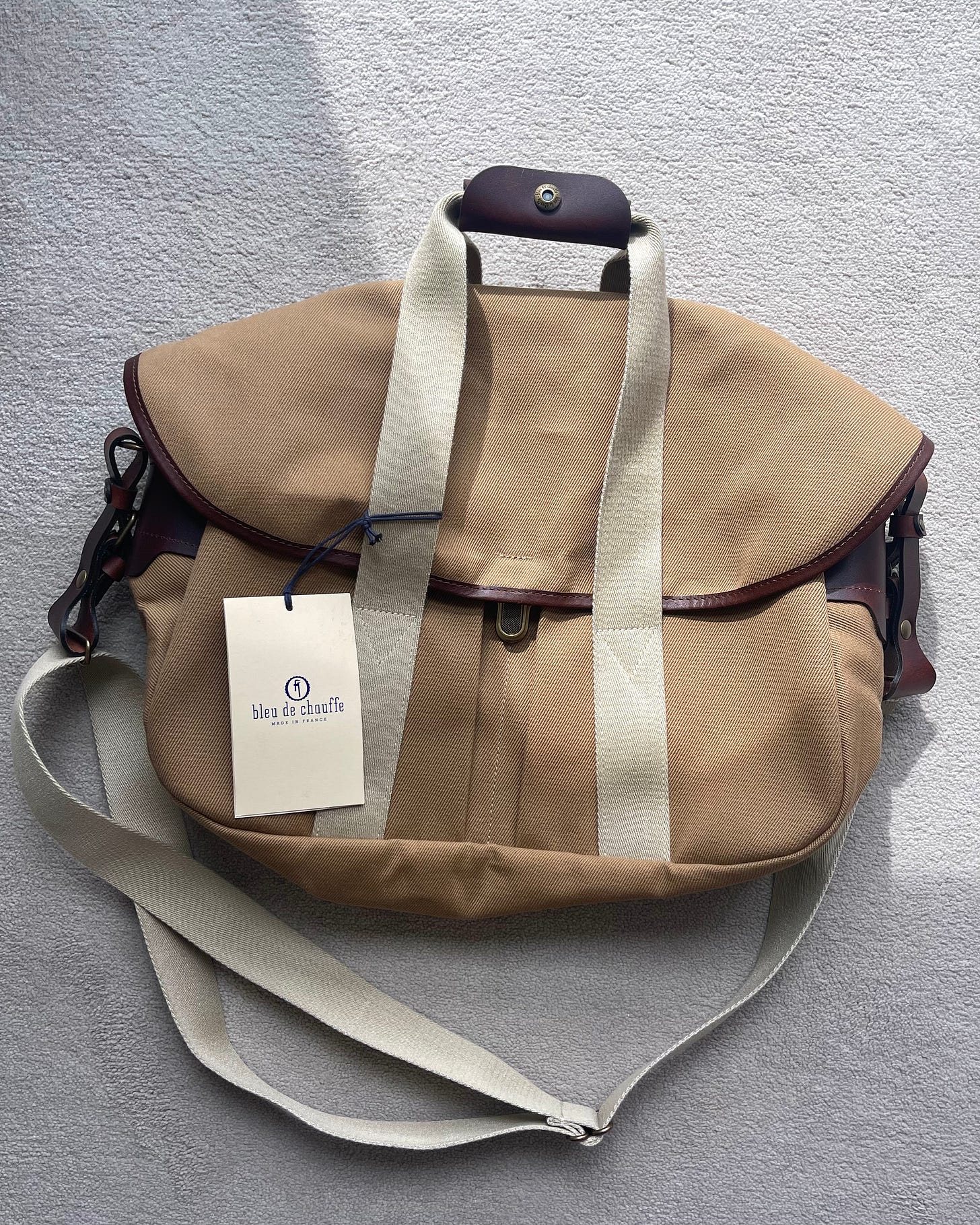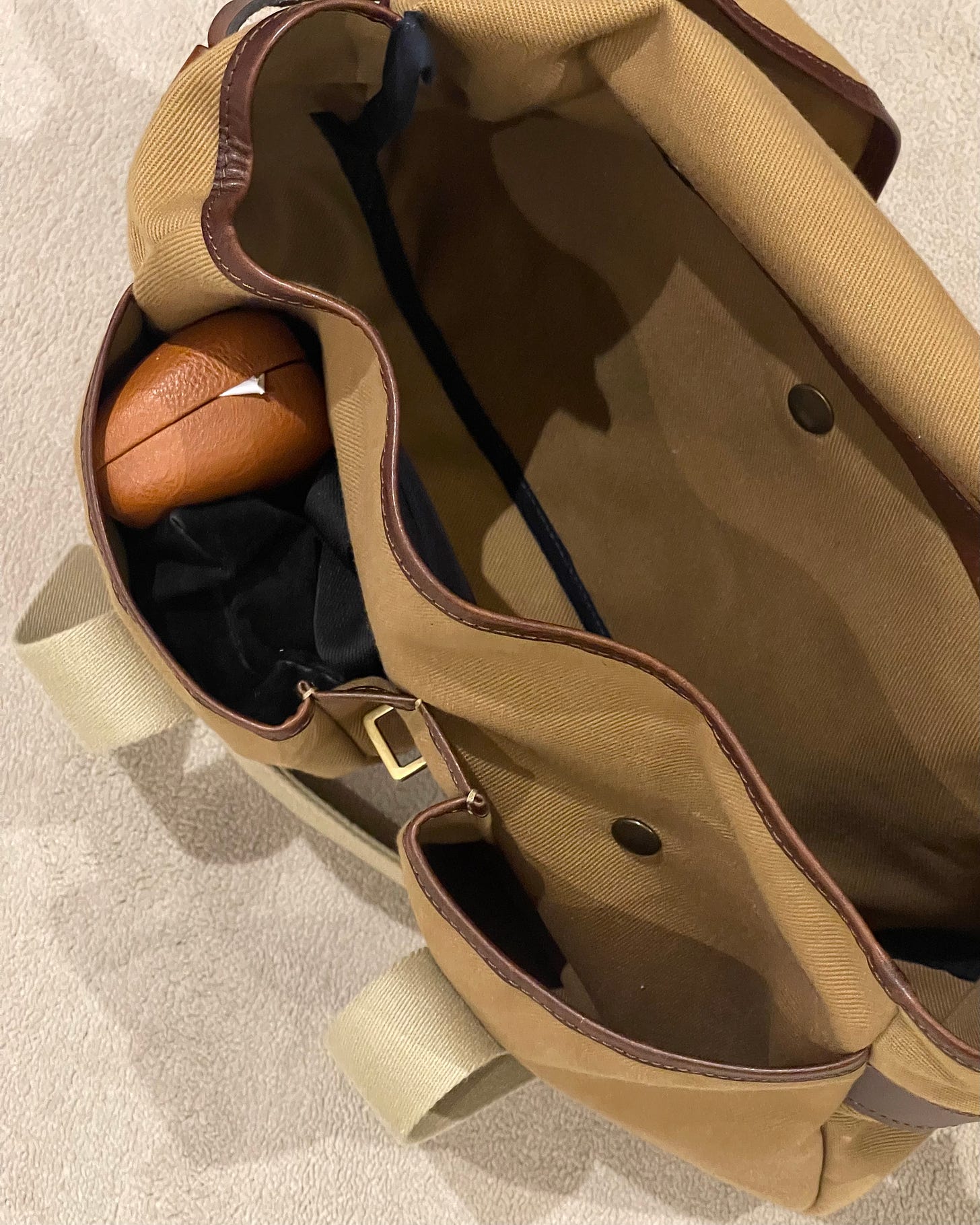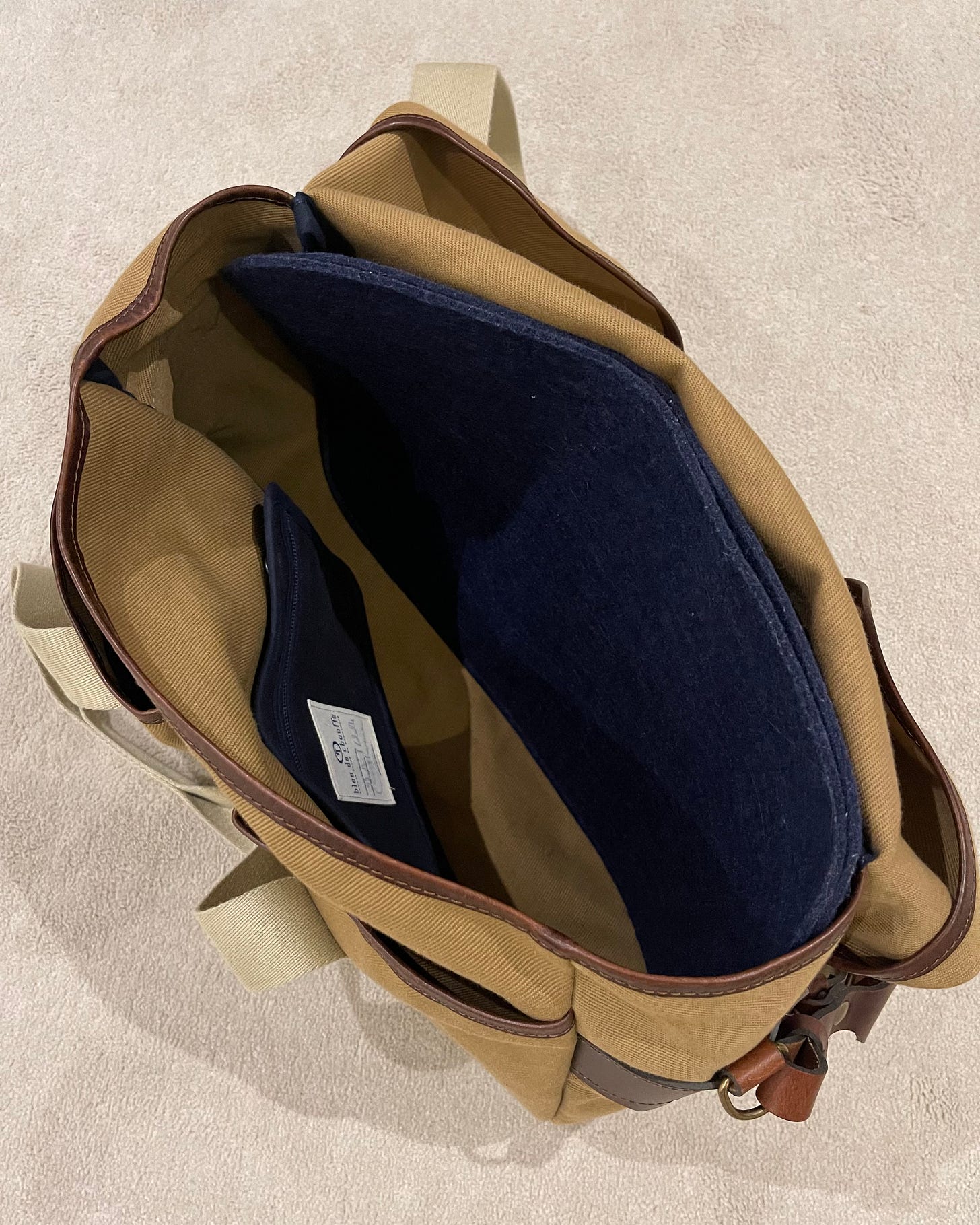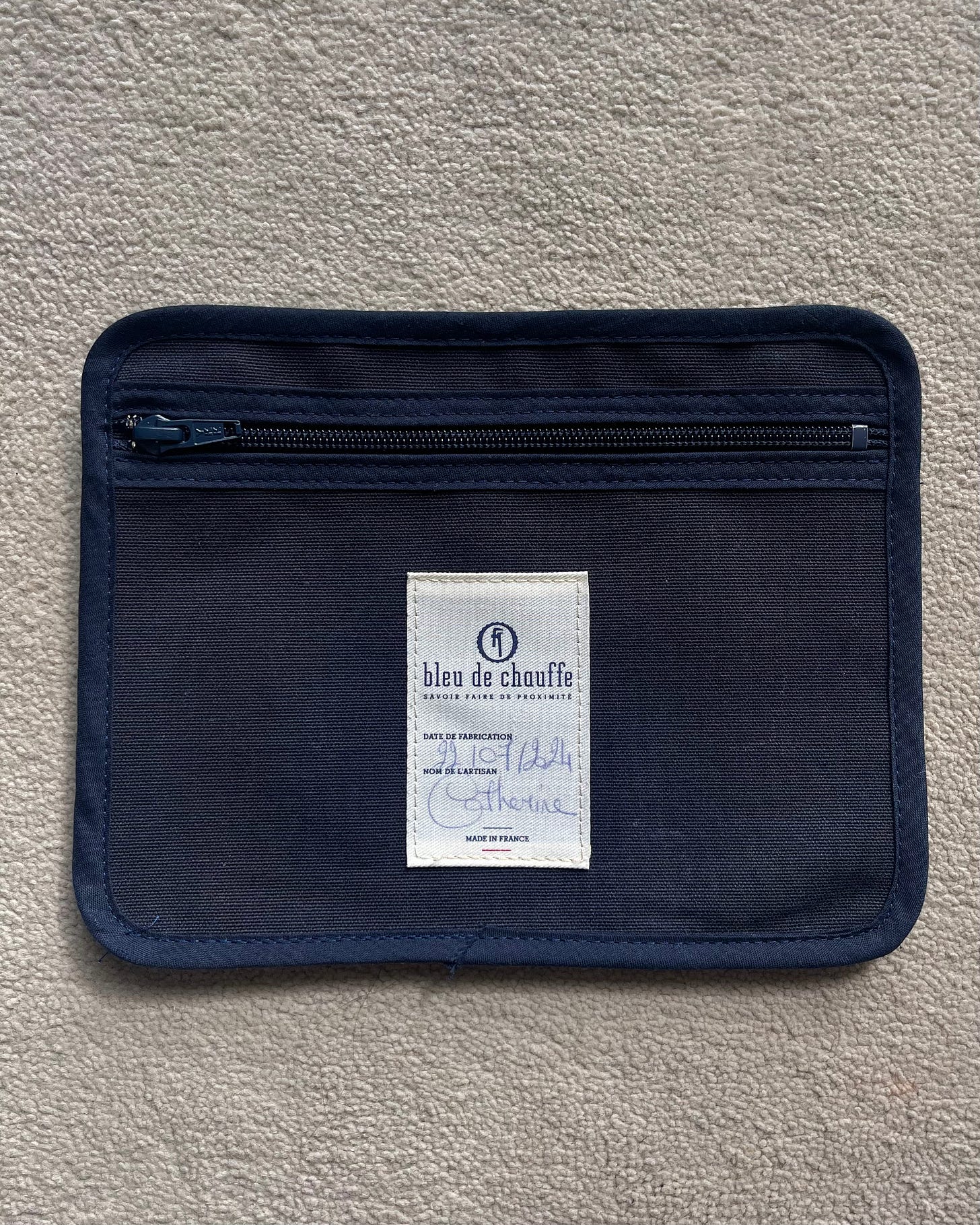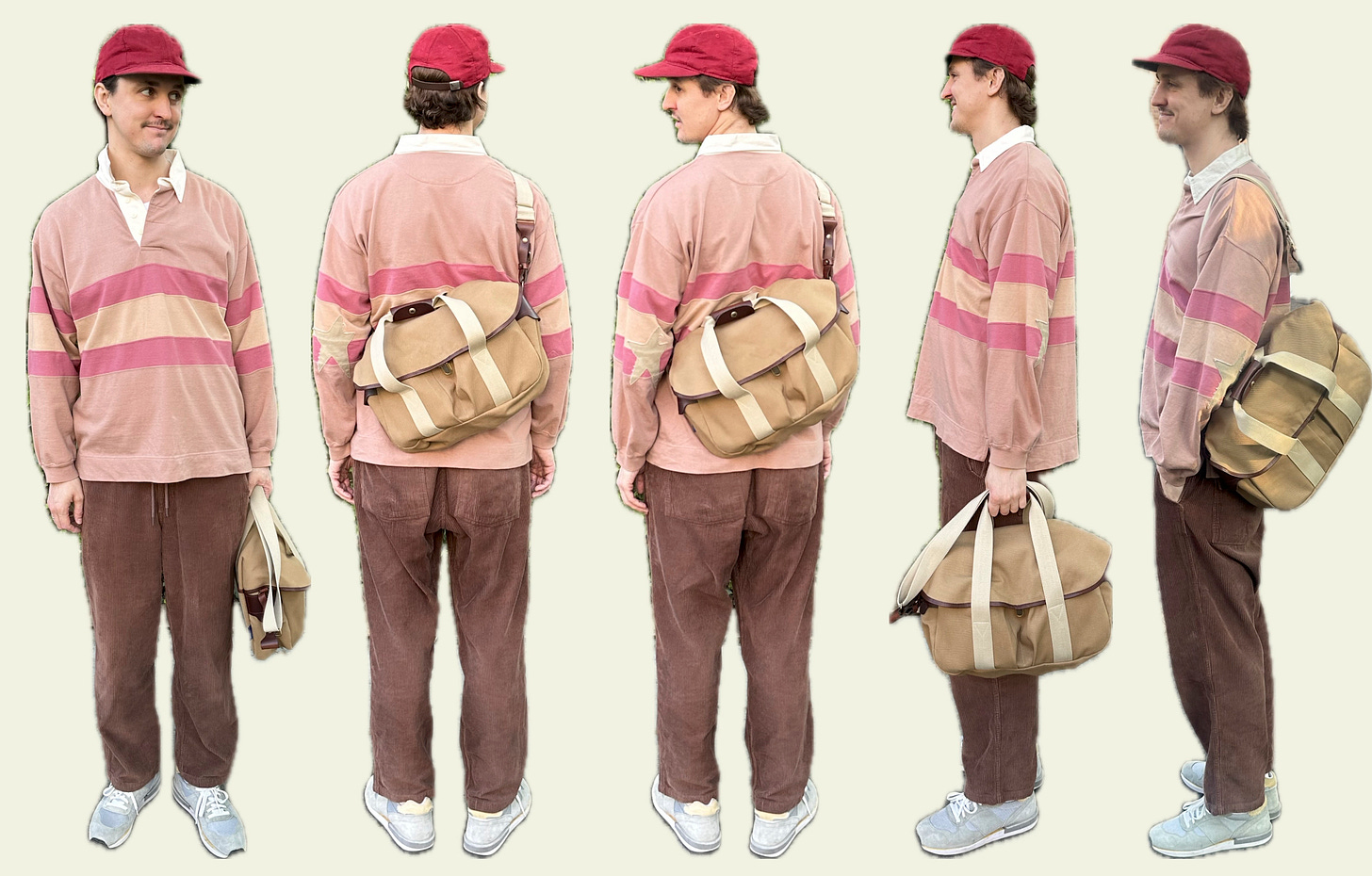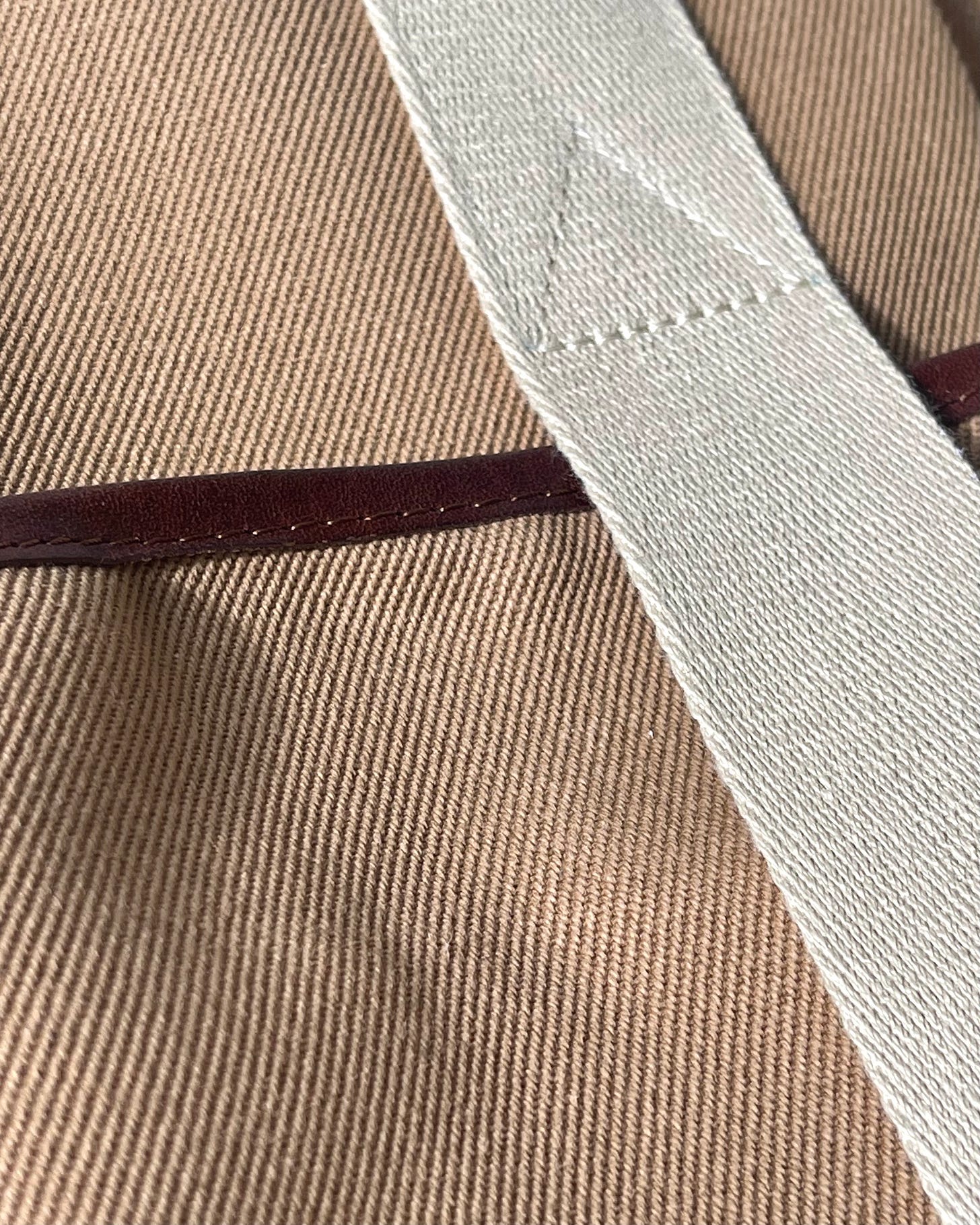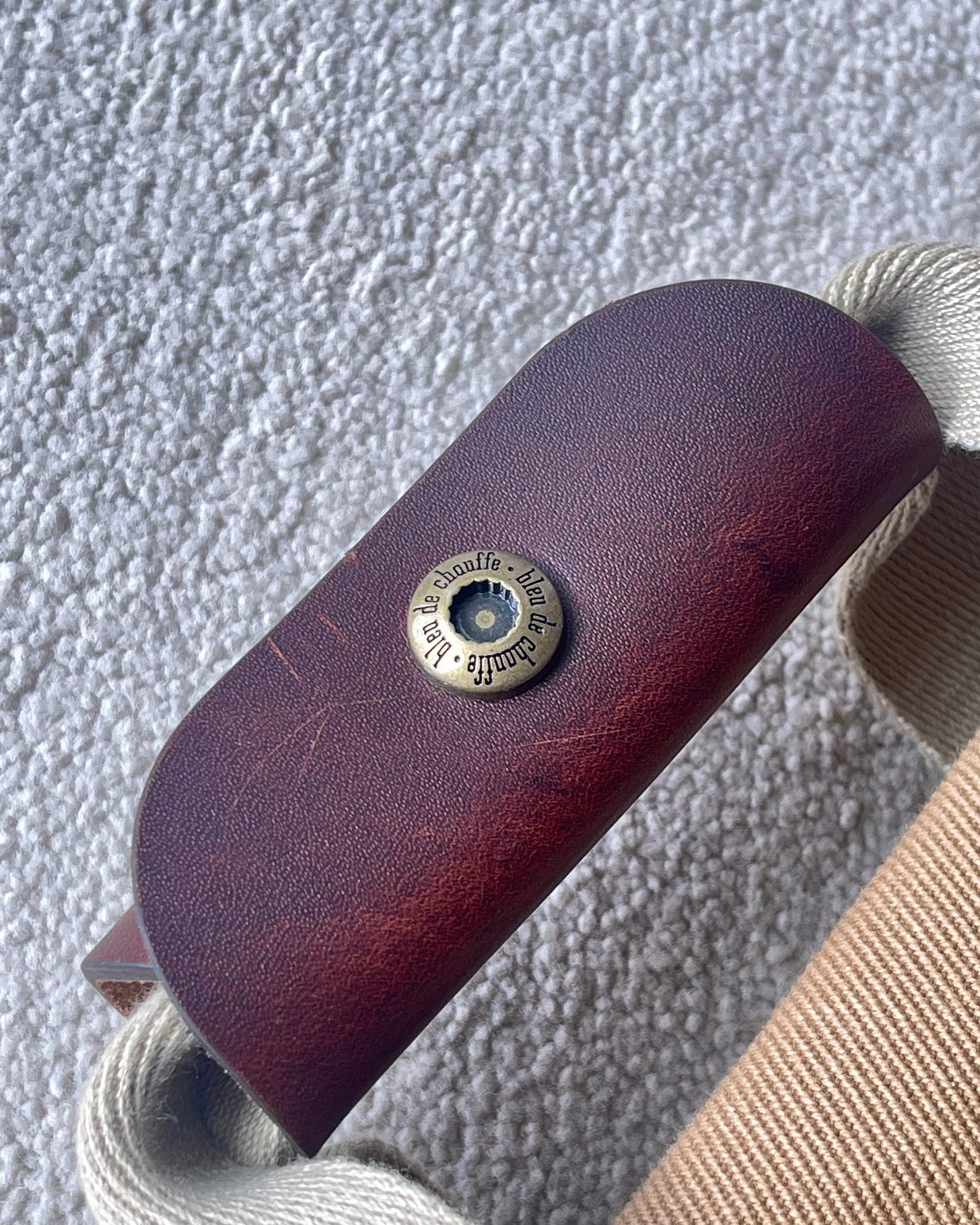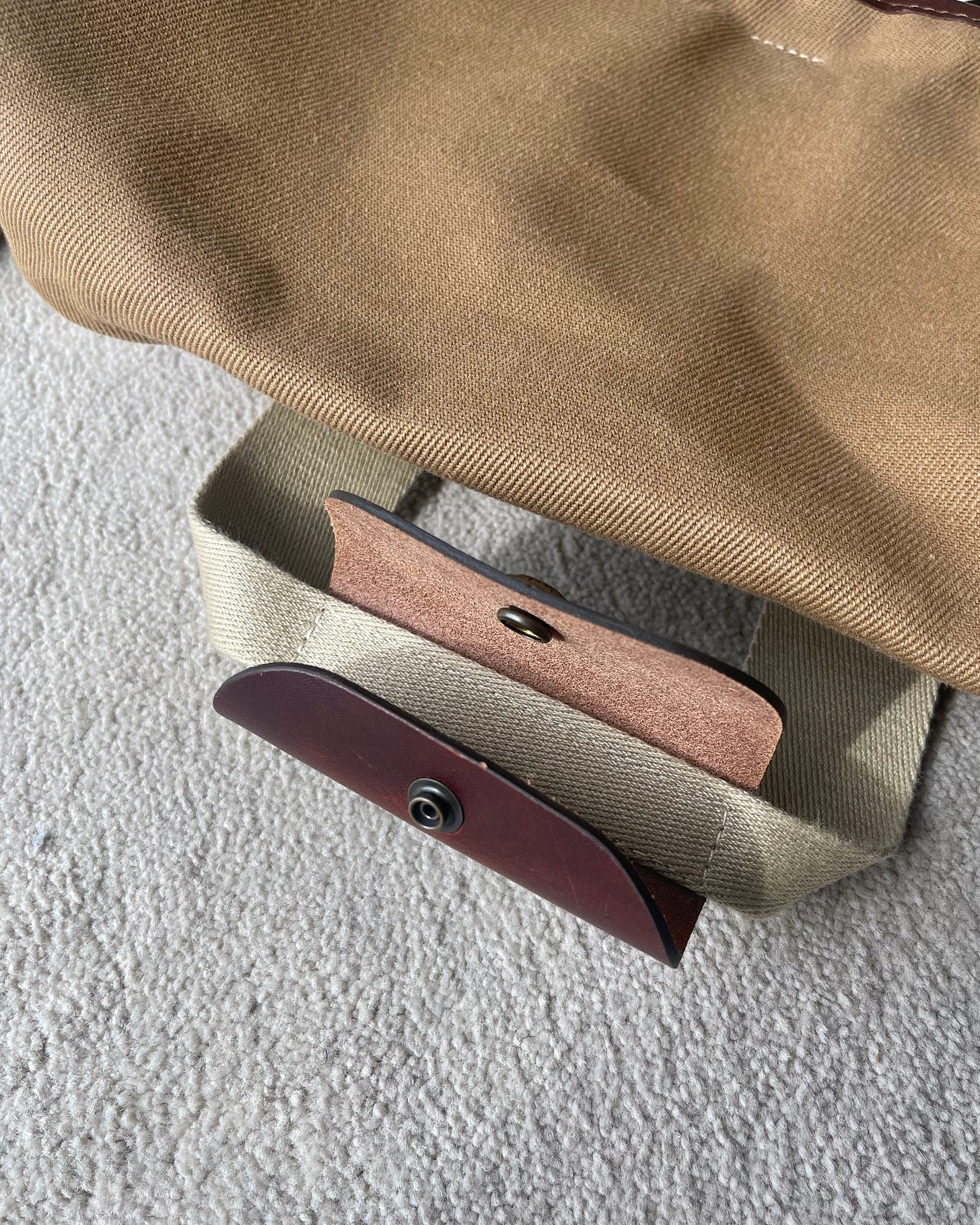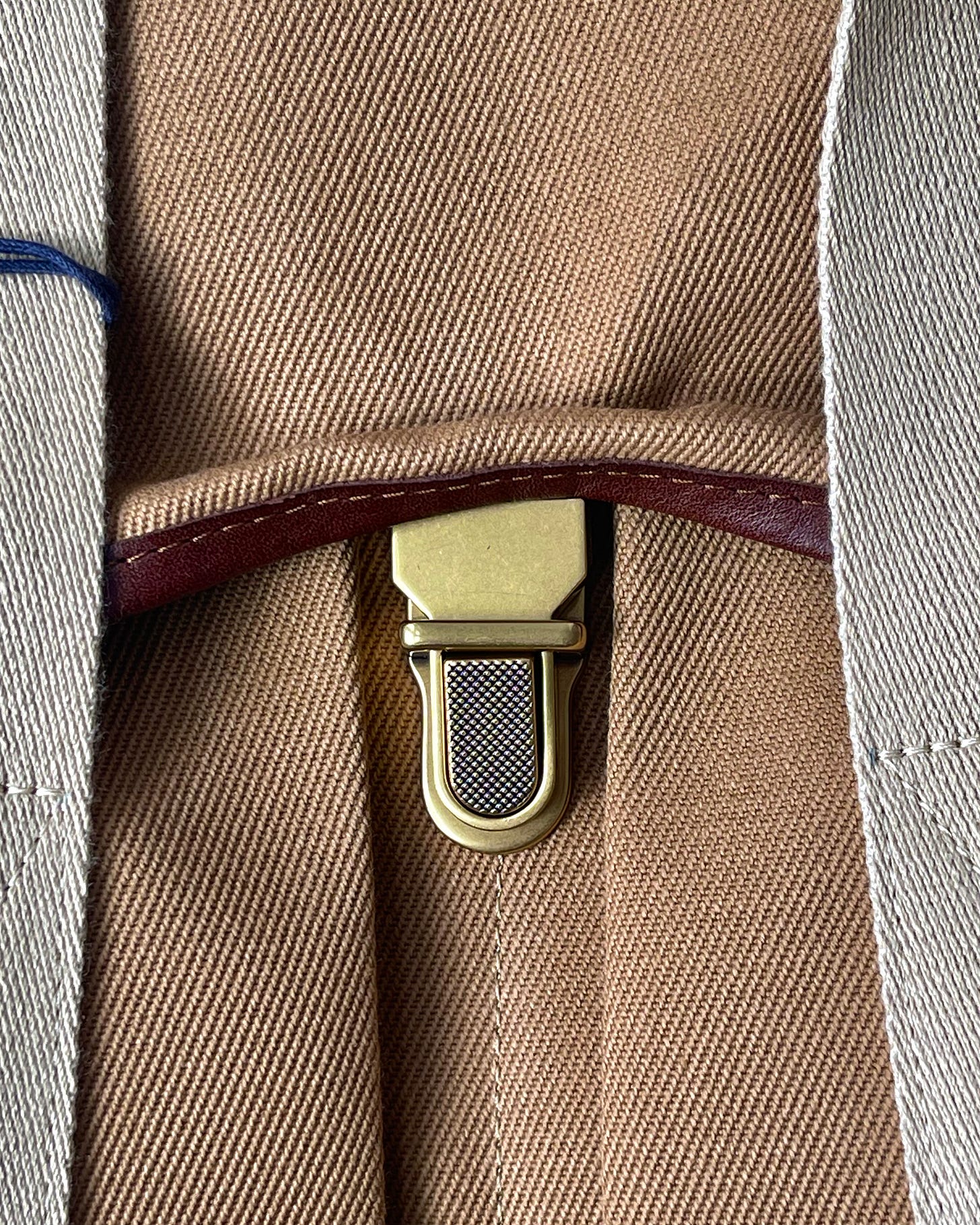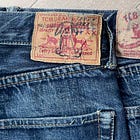TL;DR: A versatile everyday bag made from heavy-duty materials that keeps your hands free. In this review, I cover the story behind the brand, as well as the bag’s styling, proportions, size, compartments, form factor, and materials.
Spoiler
In Random Observations #14, I mentioned that a few brands reached out to offer samples of their products for review. One of them was Bleu de Chauffe, who kindly offered me their Business Musette bag: they sent me the bag for free, and I reviewed it without any commitments or edits. That’s the whole deal.
About Bleu de Chauffe
Previously, I reviewed the Bleu de Chauffe Heavyweight Champion T-shirt, and I was impressed with what happens when a brand specializing in old-school, heavy-duty bags approaches something as basic as a T-shirt. But Bleu de Chauffe is primarily a bag company. They started in 2009 and, from the very beginning, committed to manufacturing in France. Alexandre, one of the two founders, used to work for the Richemont group (Dunhill, Montblanc, IWC, Cartier, etc.), but he has always been fascinated by vintage French workwear. You can feel that influence in most of Bleu de Chauffe’s designs — they’re inspired by the gear postmen, fishermen, plumbers, and other blue-collar workers used in the first half of the 20th century. In fact, the brand’s name itself is a reference to the blue chore coats worn by railway workers of the time.
Besides crafting bags locally in the south of France, Bleu de Chauffe prides itself on sourcing materials as close as possible to avoid unnecessary back and forth before shipping products to customers. Leathers come from French and Italian tanneries, cotton canvas from British Millerain, wool felt is French, and hardware is made in France, Italy, or Belgium. Once everything reaches the workshop in Saint-Georges-de-Luzençon and the cutter prepares the leather pieces, there’s no assembly line — bags are built from start to finish by a single artisan, one of over 15. Not only does this ensure fulfilling working conditions, but it also promotes a deep dedication to the quality of the finished product.
Styling
There were two things I was cautious about: styling and size. I’m not really a fan of early 20th-century workwear; it feels too costumey to me. There’s nothing wrong with a chore coat on its own. Or work boots. It’s when you put too many of these pieces together, you risk arriving a little over a century late to the party.
But the Business Musette from Bleu de Chauffe strikes just the right balance. It obviously has some vintage vibes — especially in the shape and the big flap closure. But there are no bells and whistles that feel redundant. For example, many bags in a similar style have flap closures with two buckles — not only do they add extra visual weight, but they’re often not even functional, since the buckles close with hidden snaps. Instead, Bleu de Chauffe opted for just one, visually understated clasp (and what a clasp it is! more on this below) — surprisingly, it’s all you need to keep your belongings secure.
Proportions and Size
The other thing that often bothers me in men’s bags is size. On one end of the spectrum, you have sacoches and fanny packs — their small size creates a stark visual contrast with the rest of your outfit. On the other end, there are full-size bags that are proportionally suited to the human body. But there’s this eerie zone in between — not quite small, not quite big — and it makes me shiver. I could say such a bag makes you look like you stole it from a kid. But it’s not really about masculinity or being a grown-up. I think it goes deeper than that — something tied to nature’s laws of proportion, the golden ratio. If it’s not right, it’s just... not right.
I bring this up because too many bags fall into that eerie middle zone, and nobody talks about it. I was worried that this Bleu de Chauffe bag might be not big enough — but thankfully, it’s not. Even against my taller-than-average height, the proportions look spot on.
Curiously, the bag appears even bigger inside. At one point, I managed to fit a laptop in its sleeve, a magazine, a pair of women’s penny loafers, five books, a mushroom-shaped bouclé fabric doorstop, and a glasses case. Obviously, that’s not how you’d use the bag on a daily basis, but the point is: when needed, it delivered.
Compartments
The bag has four compartments and two internal snap-in accessories. On the front, you get two identical pockets. They remind me of open side pockets on daypacks in terms of function, except they’re larger and covered by the flap. I can easily fit a 0.5 L water bottle and a hard glasses case into one of them. The opening isn’t wide enough for a full-size book, but a pocketbook fits just fine. There’s also a pleat on one side, allowing pockets to expand outward instead of stealing space from the main compartment. And although they’re technically open, they’re covered by the main flap — so your belongings stay hidden, unlike the side pockets on a typical daypack.
Then there’s the main compartment, which comes with two snap-in accessories: a 3mm-thick felt laptop sleeve and a flat zipped pouch made of canvas, featuring the Bleu de Chauffe label with the hand-written name and date of the artisan who made the bag. Both accessories are attached with two snaps and can be removed when not needed. Otherwise, it’s one big compartment that widens slightly toward the base. It has no closure of its own, but the large flap keeps things secure and out of sight.
Lastly, there’s a full-length snap pocket at the back. It’s practically flat, so it doesn’t allow for anything too bulky. It also sits lower than the main compartment, so magazines or documents might stick out and get bent by the magnetic snap. But items like a pocketbook, phone, napkins, or other small essentials fit well — and they stay discreet, since the pocket faces your body.
Form Factor
This is the first crossbody bag I’ve ever had. So yes, it’s quite literally a life-changing bag for me. Previously, I only used three types of bags: backpacks, tote bags, and canvas grocery totes (which technically count as totes, too).
When I travel or need to carry a lot of stuff — or when the weather turns bad — I go for a backpack. I love my côte&ciel Isar backpack because it works equally well whether I’m just carrying a laptop or expanding its capacity to the limit.
I also love tote bags and have a bunch of different ones. There’s something about carrying a tote in your left hand that feels nonchalant, yet subtle. I tend to use totes on weekends and holidays.
Yet, both formats have their drawbacks. I don’t work all week just to walk around the city on weekends with a backpack. It’s too much. So I use a tote. But nonchalantly carrying a bag in your left hand all weekend long? Not an easy job either. Plus, I want to be able to pull out my film camera and shoot with both hands. Or sip some home-brewed third-wave coffee from a vacuum bottle. In those crucial moments, I put the tote over my shoulder — but it keeps sliding off. Suddenly, I’m juggling stuff instead of enjoying my weekend. Why so stressful?
Small ask: Please, share this article with your friends, colleagues, subreddits, group chats, and followers. Writing this takes time, and now I need you to help others discover it too. Thank you!
Turns out, the solution has been out there all these years — an adjustable strap that lets you wear the bag across your back. To be fair, crossbody bags lose a bit of that relaxed vibe, and they can mess with the drape of your unfastened top layers. But the benefit of having your hands free again far outweighs the aesthetic trade-off.
Another bonus of a crossbody bag: unlike with a backpack, you don’t have to take it off to access your things. Just swing it around, pop open the flap, and grab what you need. What I especially appreciate about the Bleu de Chauffe Business Musette is that you can reach into the nearest front pocket without even looking or rotating the bag. Super useful for things like a glasses case or napkins.
Although kinda obvious, it’s still worth pointing out that carrying a bag on one shoulder is less comfortable than using two. So you probably don’t want to load a crossbody bag the same way you would a backpack. The Musette’s size naturally limits that. But if you do get tired, you can switch shoulders, put it on one shoulder, or carry it by the leather handle pad — just like a tote.
Materials and Construction
The heavy-duty materials are probably my favorite part of this bag. If the rugged twill looks familiar, it’s likely not a coincidence. I don’t know if it’s the exact same fabric, but Bleu de Chauffe uses a heavy (590 g/m²) cotton canvas from British Millerain — the same mill used by the legendary American company Filson. Both brands offer bags in olive, navy, and tan, and both describe the fabric as dry waxed for water resistance. By the way, the treatment works pretty well in makeshift lab conditions:
In terms of weight, this canvas compares to 13 oz denim — similar to what’s used in my TCB 50s or 3sixteen RS-100x jeans. Except it feels a bit thicker and has more pronounced texture.
The bag doesn’t have any padding or lining, so the felt laptop sleeve isn’t just a nice-to-have — it’s necessary. All edges of the canvas are enclosed in binding: internal seams are wrapped in canvas, while the external are covered with 1mm-thick brown leather. The dark brown contrasts nicely with the tan canvas and reveals patina along the fold quickly.
A thicker 2mm leather is used for the handle pad and strap mounts. An even thicker 3mm leather is used for belts at both ends of the shoulder strap. It’s a bit of an overkill, but it does look impressive. All leather is vegetable-tanned with a pull-up effect, meaning it lightens when bent and will develop loads of character over time. The edges on the external leather parts are burnished and painted too. Although all the leather details are stitched to the canvas body, I did notice traces of water-based glue under the two of the smaller pieces — not issue at all and probably just makes the stitching process easier.
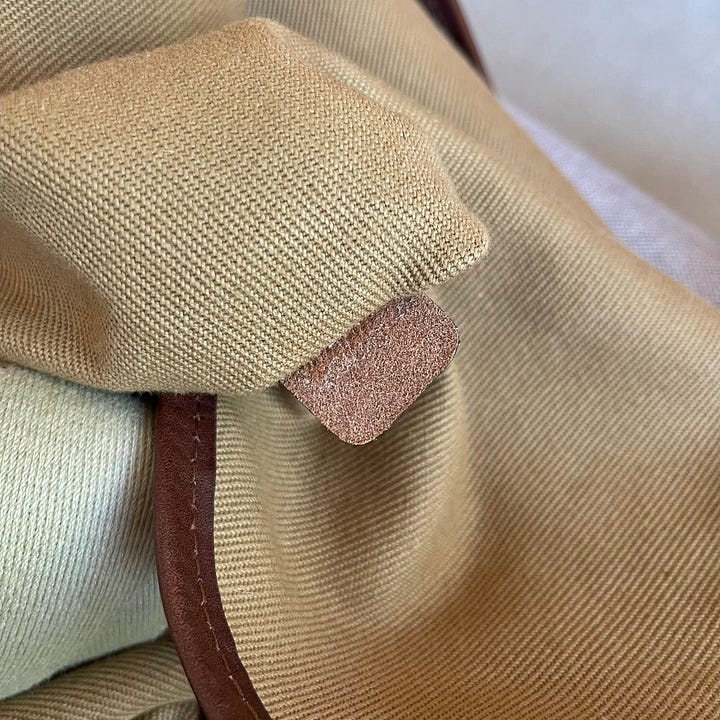
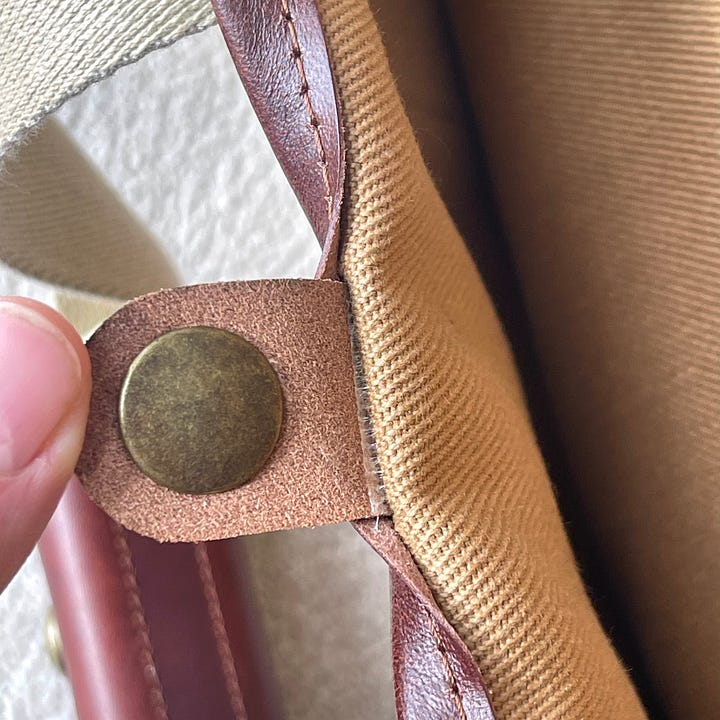
All hardware is brass and matches the brown leather and tan canvas beautifully. The standout piece is the push-button clasp that secures the flap. Small and subtle at first glance, it feels luxurious up close. I’m not exaggerating — the button is engraved with an intricate guilloché pattern, and the clasp is engraved with the brand’s name. To close the flap, just slide the clasp into the hook — and when it clicks shut, it makes this incredibly satisfying sound. You’ll want to fasten and unfasten it just to hear that click. And since it works one-handed, it quickly becomes a habit. Worth mentioning that the rest of the hardware doesn’t make any unwanted jingles.
Verdict
This is a fantastic bag. From its size and form factor to the styling and outstanding materials. I’ve already used it for work and for relaxed weekends — and it performed equally well in both settings. I’m looking forward to seeing how it develops character over time, though I suspect that’ll take a while.
At €395, it’s definitely an investment. But when you factor in small-batch French production under ethical working conditions, it also feels fair. The build quality and materials are solid — so, ultimately, it comes down to preferences in style. Personally, I like that it’s vintage-inspired without being gimmicky — fits really well with all things broadly defined as Ivy. There are other options in the €300–€500 range, but few of them can compete on all of the factors covered in this review.
Do you have experience with crossbody bags? Which are some of your favorites?
If you have any questions or feel like something is missing, please don't hesitate to ask in the comments section of this article. Would be super exciting to continue the conversation 🙌
I would greatly appreciate it if you share this review with your friends or hit a ❤️ and restack the article here on Substack to help others discover it too.
Lastly, if you enjoyed this review, feel free to check out some of my most popular articles:




